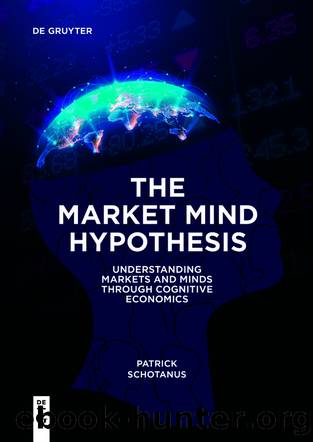The Market Mind Hypothesis by Patrick Schotanus

Author:Patrick Schotanus
Language: eng
Format: epub
Publisher: De Gruyter
Published: 2023-10-02T04:17:15.982000+00:00
9.2.3
Readiness Potential
Readiness Potential (RP) is the English translation of the original German Bereitschaftspotential, suggesting a âreadinessâ to act. Technically, RP reflects cortical brain activity (measured via EEG), in particular a build-up of neuronal activity, ahead of voluntary action or movement. Tests of RP are generally done in a laboratory setting. Subjects, whose brains are monitored, are asked to (repeatedly) perform an instructed movement spontaneously without any forethought or pre-planning. Researchers are particularly interested in the brain activity leading up to those movements which they measure in narrow windows of a few seconds. Researchers are also interested in the timing of the movement itself and the perceived timing of the decision to move.
The RP has a rich history going back to the 1960s when it was first discovered. In 1983 neuroscientist Benjamin Libet (with colleagues) published seminal research showing (presumably) that the feeling of having decided to act, the so-called conscious decision, emerges long after the neuronal decision has already been made in the brain. Libetâs account emphasised the role of the unconscious, while the conscious decision is tacked onto the decision-making process after-the-fact without playing any causal role. His argument rested on the time course of the RP, whereby the gradual build-up of neuronal activity in the pre-motor area precedes not only the onset of movement, but also the conscious decision to initiate the movement.
Since then the RP has always been presumed to reflect a process of planning and preparation for movement. More recently, however, Schurger, Sitt and Deheane (2012)1 challenged this presumption by applying a stochastic accumulator model, including a so-called Libetus-interruptus task: subjects perform the standard Libet task, but are told that they may sometimes, i.e. randomly, be interrupted by an auditory âclick,â in which case they are to perform the movement (in this case a button press) as quickly as possible. The authors found a slow build-up of neuronal activity preceding fast reactions to the click, that began long before the click itself. In short, they argue that RP might reflect ongoing stochastic fluctuations in brain activity whose crests tend to coincide with the onset of movement. This latter interpretation has since received additional support. Of particular interest is a study by Murakami et al. (2014) which found evidence for an accumulator process in area M2 of rats (homolog of human premotor cortex) performing a task where the rat could spontaneously abandon waiting for a large reward and instead opt for an immediate and certain, albeit smaller reward.
The gist of the argument from this stochastic RP interpretation is the following: when the imperative to act is weak, for example due to lack of evidence, the decisionâs timing that leads to movement is partly determined by ongoing sub-threshold fluctuations in brain activity. To be clear, this timing is the precise moment at which the decision threshold is crossed. Time locking to movement onset ensures that these slow fluctuations are recovered in the event-locked average in the form of a gradual build-up or accumulation. By this account the RP
Download
This site does not store any files on its server. We only index and link to content provided by other sites. Please contact the content providers to delete copyright contents if any and email us, we'll remove relevant links or contents immediately.
| Analysis & Strategy | Bonds |
| Commodities | Derivatives |
| Futures | Introduction |
| Mutual Funds | Online Trading |
| Options | Portfolio Management |
| Real Estate | Stocks |
Pioneering Portfolio Management by David F. Swensen(5616)
Rich Dad Poor Dad by Robert T. Kiyosaki(5168)
How To Win Friends and Influence People by Dale Carnegie(3782)
The Money Culture by Michael Lewis(3293)
The Dhandho Investor by Mohnish Pabrai(3176)
The Wisdom of Finance by Mihir Desai(3087)
Liar's Poker by Michael Lewis(2821)
The Intelligent Investor by Benjamin Graham Jason Zweig(2602)
The ONE Thing by Gary Keller(2531)
Mastering Bitcoin: Programming the Open Blockchain by Andreas M. Antonopoulos(2522)
Investing For Dummies by Eric Tyson(2478)
How to Day Trade for a Living: Tools, Tactics, Money Management, Discipline and Trading Psychology by Andrew Aziz(2454)
How to Win Friends and Influence People by Dale Carnegie(2444)
Rich Dad Poor Dad: What The Rich Teach Their Kids About Money - That The Poor And Middle Class Do Not! by Robert T. Kiyosaki(2439)
Fooled by Randomness: The Hidden Role of Chance in Life and in the Markets by Nassim Nicholas Taleb(2421)
Zero Hour by Harry S. Dent Jr. & Andrew Pancholi(2252)
Market Wizards by Jack D. Schwager(2171)
Rich Dad's Guide to Investing by Robert T. Kiyosaki(2117)
How to Pay Zero Taxes, 2018 by Jeff A. Schnepper(2106)
